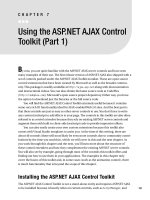Using Server Controls in ASP.NET AJAX
Bạn đang xem bản rút gọn của tài liệu. Xem và tải ngay bản đầy đủ của tài liệu tại đây (670.79 KB, 22 trang )
Using Server Controls in ASP.NET
AJAX
T
his chapter follows on from Chapter 5, which introduced you to the ASP.NET AJAX
server controls and showed you how to use them. In this chapter, you’ll look at two small
ASP.NET AJAX applications and dissect them to see how they work. In the process, you’ll
glean a lot of new information about how to use the ASP.NET AJAX server controls to
build powerful AJAX-style applications and how to extend your existing applications with
asynchrony.
One of the applications that will be discussed happens to be also one of the first
small apps built to showcase some of the features of ASP.NET AJAX. This application,
called Scott’s ToDo List, is a great example of a simple data-driven AJAX-enabled ASP.NET
web application. But before that, let’s combine the controls discussed in the previous
chapter to create a practical solution to a common scenario.
Using the UpdatePanel, UpdateProgress, and
Timer Controls
For this first example, consider the following scenario: You have a data-driven web page
that needs to continuously alert the user with fast changing data, for instance, a page that
displays the major financial indices in the U.S. capital markets: Dow Jones Industrial Aver-
age (DJIA), NASDAQ, and S&P500. One approach is to place a
<META>
tag in your page with
refresh values that then force the page to refresh itself in regular intervals based on the pro-
vided value. But if you wanted to make the page behave more like a desktop application
and update the data without page refresh, AJAX is definitely the recommended path.
By now, you have seen the basics of the
ScriptManager
,
UpdatePanel
,
UpdateProgress
,
and the
Timer
server controls in ASP.NET AJAX and have a good understanding of their
functionality. So, with that in mind, let’s build a quick application that does exactly what
was talked about earlier: displays the three main indices of the American capital markets
and continues to update the page with (simulated) real-time data without any page
refresh.
109
CHAPTER 6
828-8 CH06.qxd 9/28/07 4:46 PM Page 109
To accomplish this, create a new ASP.NET AJAX-enabled web site. Because the
ScriptManager
control has already been placed on the page, drop new
UpdatePanel
,
UpdateProgress
, and
Timer
controls onto the page called MarketData.aspx as shown in
Figure 6-1.
Figure 6-1. New page with ASP.NET AJAX server controls
After that, you just need an HTML table and a few label controls for the user inter-
face. Let’s take a look at the actual markup for this page:
<%@ Page Language="C#" AutoEventWireup="true" CodeFile="MarketData.aspx.cs" ➥
Inherits="MarketData" %>
<!DOCTYPE html PUBLIC "-//W3C//DTD XHTML 1.0 Transitional//EN" ➥
" /><html xmlns=" >
<head runat="server">
<title>Market Summary</title>
</head>
<body>
<form id="form1" runat="server">
<div>
<asp:ScriptManager ID="ScriptManager1" runat="server">
</asp:ScriptManager>
</div>
<u>Market Summary:</u>
<br /><br />
<asp:UpdatePanel ID="UpdatePanel1" runat="server">
<Triggers>
<asp:AsyncPostBackTrigger ControlID="Timer1" EventName="Tick" />
CHAPTER 6
■
USING SERVER CONTROLS IN ASP.NET AJAX110
828-8 CH06.qxd 9/28/07 4:46 PM Page 110
</Triggers>
<ContentTemplate>
<table border="1">
<tr>
<td><asp:Label ID="Label1" runat="server" Text="DJIA"></asp:Label>
</td>
<td align=right><asp:Label ID="lblDowJones" runat="server"
Text="12000"></asp:Label></td>
</tr>
<tr>
<td><asp:Label ID="Label2" runat="server" Text="NASDAQ"></asp:Label>
</td>
<td align=right><asp:Label ID="lblNasdaq" runat="server"
Text="2500"></asp:Label></td>
</tr>
<tr>
<td><asp:Label ID="Label3" runat="server" Text="S&P 500">
</asp:Label></td>
<td align=right><asp:Label ID="lblSnp" runat="server" Text="1400">
</asp:Label></td>
</tr>
</table>
</ContentTemplate>
</asp:UpdatePanel>
<asp:UpdateProgress ID="UpdateProgress1" runat="server">
<ProgressTemplate>Updating...</ProgressTemplate>
</asp:UpdateProgress>
<asp:Timer ID="Timer1" runat="server" Interval="2000" OnTick="Timer1_Tick" />
</form>
</body>
</html>
By now, you are probably familiar with most of this code. Basically, we are using an
<asp:AsyncPostBackTrigger>
trigger in the main
UpdatePanel
control and associating it with
the
Tick
event of the
Timer
control. To better show the updates taking place, you use an
UpdateProgress
control with the text “Updating…” in its
<ProgressTemplate>
tag. In the
Timer
control, you set the interval to 2 seconds (2000 milliseconds) and point the
OnTick
event to the
Timer1_Tick
event handler in the code behind, which will be responsible for
writing the logic to fetch and display the new values for the three indices.
Obviously, the point of this application is to showcase a good scenario for using
ASP.NET AJAX server controls and not to build a practical market data reporting
application. As such, the initial values for the three indices have been hard-coded in the
tags themselves. The initial value for the DJIA is set to
12000
, the NASDAQ is set to
2500
,
CHAPTER 6
■
USING SERVER CONTROLS IN ASP.NET AJAX 111
828-8 CH06.qxd 9/28/07 4:46 PM Page 111
and the S&P is set to
1400
. There will also be some simple logic to update the display
values of those indices with some fictitious data as shown in the following code block in
the code-behind class:
protected void Timer1_Tick(object sender, EventArgs e)
{
System.Threading.Thread.Sleep(1000);
lblDowJones.Text = ((int.Parse(lblDowJones.Text)) + 1).ToString();
lblNasdaq.Text = ((float.Parse(lblNasdaq.Text)) + 0.5).ToString();
lblSnp.Text = ((float.Parse(lblSnp.Text)) + 0.25).ToString();
}
First, you initiate a one-second delay by pausing the current thread, and then you
increment the values of each label control by holding the value for the market indices
and assigning them back to the corresponding labels. As you can see, the value for DJIA
is incremented by one point, the NASDAQ index is incremented by a half point, and the
S&P 500 index is incremented by a quarter point. This update effectively takes place every
three seconds because the
Timer1_Tick
event is called every two seconds followed by a
one-second delay in the method.
Figure 6-2 shows MarketData.aspx in the browser during an update.
Figure 6-2. MarketData.aspx updates the values for the indices every three seconds.
CHAPTER 6
■
USING SERVER CONTROLS IN ASP.NET AJAX112
828-8 CH06.qxd 9/28/07 4:46 PM Page 112
As you can see, the index values in the page change every two seconds (with a one-
second pause between updates and one second after the update without any refresh at
all). If you were to refresh the page, you would notice all three values being reset to their
initial values that were set in the page designer. Now view the source in the browser, and
notice the generated client code:
<!DOCTYPE html PUBLIC "-//W3C//DTD XHTML 1.0 Transitional//EN" ➥
" /><html xmlns=" >
<head><title>
Market Summary
</title></head>
<body>
<form name="form1" method="post" action="marketdata.aspx" id="form1">
<div>
<input type="hidden" name="__EVENTTARGET" id="__EVENTTARGET" value="" />
<input type="hidden" name="__EVENTARGUMENT" id="__EVENTARGUMENT" value="" />
<input type="hidden" name="__VIEWSTATE" id="__VIEWSTATE"
value="/wEPDwULLTE0NDcxODQxOTNkZBVyy3kZPCaHntKg63oJ/pIvM3rf" />
</div>
<script type="text/javascript">
<!--
var theForm = document.forms['form1'];
if (!theForm) {
theForm = document.form1;
}
function __doPostBack(eventTarget, eventArgument) {
if (!theForm.onsubmit || (theForm.onsubmit() != false)) {
theForm.__EVENTTARGET.value = eventTarget;
theForm.__EVENTARGUMENT.value = eventArgument;
theForm.submit();
}
}
// -->
</script>
<script src="/AjaxChapter7/WebResource.axd?d=2k35oXVI5C1fsATKa8kOpQ2&
amp;t=633008366579531250" type="text/javascript"></script>
<script src="/AjaxChapter7/ScriptResource.axd?d=zmjix_F07KXpA6m02uaB_q52a3TPiFz24p4h
x51TaC3HYCrvlQk4ongK5kg1IR8XFf7DTDlMUGM-Uucre6H3Yy1K_8vru25LXaz6lsl_p0U1&t=
633051881703906250" type="text/javascript"></script>
CHAPTER 6
■
USING SERVER CONTROLS IN ASP.NET AJAX 113
828-8 CH06.qxd 9/28/07 4:46 PM Page 113
<script src="/AjaxChapter7/ScriptResource.axd?d=zmjix_F07KXpA6m02uaB_
q52a3TPiFz24p4hx51TaC3HYCrvlQk4ongK5kg1IR8XFf7DTDlMUGM-Uucre6H3Y1DyFBKNihsy-
OGXMoZEYtg1&t=633051881703906250" type="text/javascript"></script>
<script src="/AjaxChapter7/ScriptResource.axd?d=zmjix_F07KXpA6m02uaB_
q52a3TPiFz24p4hx51TaC3HYCrvlQk4ongK5kg1IR8XFf7DTDlMUGM-Uucre6H3Y9OmwbS8Igy_KW_
7MLdflso1&t=633051881703906250" type="text/javascript"></script>
<div>
<script type="text/javascript">
//<![CDATA[
Sys.WebForms.PageRequestManager._initialize('ScriptManager1',
document.getElementById('form1'));
Sys.WebForms.PageRequestManager.getInstance()._updateControls(['tUpdatePanel1'],
['Timer1'], [], 90);
//]]>
</script>
</div>
<u>Market Summary:</u>
<br /><br />
<div id="UpdatePanel1">
<table border="1">
<tr>
<td><span id="Label1">DJIA</span></td>
<td align=right><span id="lblDowJones">12000</span></td>
</tr>
<tr>
<td><span id="Label2">NASDAQ</span></td>
<td align=right><span id="lblNasdaq">2500</span></td>
</tr>
<tr>
<td><span id="Label3">S&P 500</span></td>
<td align=right><span id="lblSnp">1400</span></td>
</tr>
</table>
</div>
<div id="UpdateProgress1" style="display:none;">
Updating...
</div>
<span id="Timer1" style="visibility:hidden;display:none;"></span>
<script type="text/javascript">
<!--
Sys.Application.initialize();
CHAPTER 6
■
USING SERVER CONTROLS IN ASP.NET AJAX114
828-8 CH06.qxd 9/28/07 4:46 PM Page 114
Sys.Application.add_init(function() {
$create(Sys.UI._UpdateProgress, {"associatedUpdatePanelId":null,"displayAfter"
:500,"dynamicLayout":true}, null, null, $get("UpdateProgress1"));
});
Sys.Application.add_init(function() {
$create(Sys.UI._Timer, {"enabled":true,"interval":2000,"uniqueID":"Timer1"},
null, null, $get("Timer1"));
});
// -->
</script>
</form>
</body>
</html>
The ASP.NET AJAX server controls emit JavaScript functions that copy and build a
new
innerHTML
property of the
<span>
or
<div>
tags that contain the value getting updated.
They are also responsible for generating a request on
XMLHttpRequest
and a callback for
when the client request is complete. The callback then builds HTML code to put on the
innerHTML
property of the named
<span>
or
<div>
tags.
This is basically how the
UpdatePanel
works under the hood. It uses
Sys.WebForms.PageRequestManager
to set up an asynchronous callback. These scripts are all
automatically generated by the
ScriptManager
. Near the end of the source in the last lines
of script in the page, you can also see the parameters of the
Timer
control being passed
via JavaScript with the interval set to two seconds and the ID of the control being
Timer1
.
Delving deeper into the generated script details piece by piece would fast take us beyond
the scope of this chapter. If you are interested in having a more in-depth understanding
of the inner workings of these script blocks on the page, you can view them by using
either an HTTP sniffer, the JSView plug-in for FireFox (
/>en-US/firefox/addon/2076
), or other third-party tools designed to capture the browser
output.
Using a Task List Manager
One of the first reference applications publicly available for ASP.NET AJAX was Scott
Guthrie’s task list manager, ToDo List. This application is a simple yet powerful demon-
stration of the power of the ASP.NET 2.0 Framework and how easy it is to extend it for
AJAX-style functionality using ASP.NET AJAX.
This application is a simple task manager using SQL Server 2005 Express edition as
a container for its data. You can download and run it on your local machine with the
complete source available online. Feel free to customize this app in any way you want
by adding or modifying new items as long as you accommodate these changes in the
CHAPTER 6
■
USING SERVER CONTROLS IN ASP.NET AJAX 115
828-8 CH06.qxd 9/28/07 4:46 PM Page 115
provided database. The entire application really consists of a single .aspx page and a
.master page. Figure 6-3 shows the main screen for this application.
■
Note
You can download Scott’s ToDo List application in addition to video tutorials about this and other
ASP.NET AJAX topics on
.
Figure 6-3. The task list manager application
CHAPTER 6
■
USING SERVER CONTROLS IN ASP.NET AJAX116
828-8 CH06.qxd 9/28/07 4:46 PM Page 116









